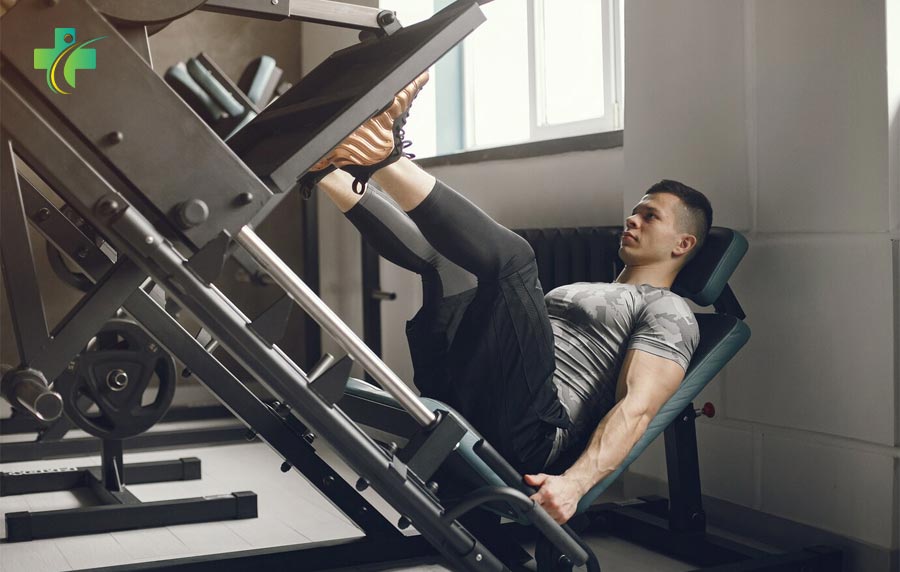Leg press foot placement means your placement of feet on the leg press machine. By changing the position of your leg in the leg press machine, you can target different muscle groups in your legs and highlight the movements during exercise.
What Is A Leg-Press Foot Placement Machine?

The leg press machine is an exercise apparatus which is designed for the leg muscle. It’s serving as a reliable alternative to traditional leg exercises like squats and lunges. The activity starts with simply sitting down and then pushing against the platform which comes up with an adjustable weight. It’s also going to allow you to choose the accurate resistance level which is suitable for you.
This seated leg press foot placement machine provides a controlled and secure environment for performing the leg exercises. That’s why it’s becoming the most popular exercise for people who like to have toned lower body and leg muscles.
How To Do Leg-Press Foot Placement?
We are examining the specifics of the five primary foot placement for leg press positioning techniques that we employ.
- Positioned in the middle of the platform (standard stance): The quads, glutes, and hamstrings were worked. Place your feet in the middle of the leg-press platform. In this position, the major leg muscles are engaged in a balanced manner.
- Elevated Foot Positioning: As mentioned, raise your foot placement on leg press farther up the platform. This highlights the glutes and hamstrings. It is especially effective when directed towards the posterior chain.
3. Low Positioning of the Foot: Retain your feet lower on the platform. This makes the quadriceps more prominent and engages the calf muscles.
4. Narrow Position: Bring your feet closer together. The primary goal of a leg press foot placement stance is to work the quadriceps. It is incredibly effective at building quad strength.
5. Broad Stepping: The abductors, hamstrings, and glutes were worked.
Spread out where your feet are placed. This engages the hamstrings, glutes, and muscles of the outer thigh (abductors). It’s excellent for the lower body’s overall growth.
Look, each foot positioning has special benefits and drawbacks. However, you must be aware of your muscle concentration if you like to enhance your outcomes. Here, change your angle to match your toe angle. in order to target particular muscle groups. pointing toes in and out in the direction of abductors.
6. Standard Positioning: This position is mostly used for hip and knee extension. For that, it offers a great deal of versatility.
Wide Placement: Spreads thighs out and increases hip abduction. Placement narrowly: Focuses on knee extension with minimal hip involvement.
Advantages Of Doing Leg Press Foot Placements:

This leg press foot location has certain advantages because it flexes specific foot muscles. However, let’s get more specifics.
Enhanced Activation Of Muscles:
Use certain muscles, as we instructed, to help you attain the strength you desire and a more concentrated development.
Change Up Your Exercise Routine:
You can avoid injuries and make your workouts less monotonous by experimenting with different foot placement techniques.
Injury prevention: Targeting certain muscle groups can assist address imbalances and potentially reduce the chance of injury.
Is Leg Press Foot Placement Helpful?
The leg-press foot position changes based on your objectives and needs. It might be quite advantageous. Consider this: Which muscles do you want to strengthen? Choose the position that best achieves your goal (wide for adductors, high for glutes, etc.). Do you have any limitations or injuries? You might not be a suitable fit for certain places if you have certain issues. What level of leg press foot placement exercise do you possess? For novice lifters, standard placement can be ideal, but more seasoned lifters can try out various configurations.
Alternatives Of Leg Press Foot Placement

Here are some substitutes for leg press machine foot placement.
As an alternative to switching up your foot placements during the leg press, you can use different exercises to target different muscles.
Regarding Quads: Squats:
You can do these exercises in a range of foot positions, such as narrow for your quadriceps and sumo for your inner thighs. Lunges can be performed in two different ways, walking and reversing; forward lunges work best to target the quadriceps. Leg extensions: This equipment is specifically designed to strengthen the quadriceps.
Regarding Glutes:
These leg press foot placement effectively work the glutes and can be performed with a barbell, bodyweight, or resistance bands. Glute bridges are similar to hip thrusts in that they require lying down and focused hip extension. Dumbbell sumo deadlifts: This compound exercise targets the glutes and hamstrings. Romanian deadlifts: strengthen the lower back and hamstrings by hingeing the hips. Glute-ham raises: This machine exercise works the hamstrings by bending the knee. Nordic curls are a bodyweight exercise that works the hamstrings by having the person lower themselves backward onto a stability ball.
Additional Options:
Provides a squatting motion that is more akin to a leg press. Belt squat exercise works for the same muscle groups as the leg press and improves torso alignment. Sissy squat: Works the quads and calves while concentrating on knee flexion.
Choose your exercises according to the equipment’s accessibility and your level of fitness. Maintain proper form to lower the chance of injury and promote muscle activation. Consult a trainer or physical therapist for personalized guidance.
Bottomline
Finally, seek advice from a qualified trainer regarding the leg press foot placement. Use this if necessary, but avoid overdoing it with the workout. Additionally, you ought to talk about alternatives with your trainer.
Must Read :
- How To Use A Chest Press Machine?
- What Are Some Bosu Ball Exercises?
- What Is Clamshell Exercise? How To Do It?

